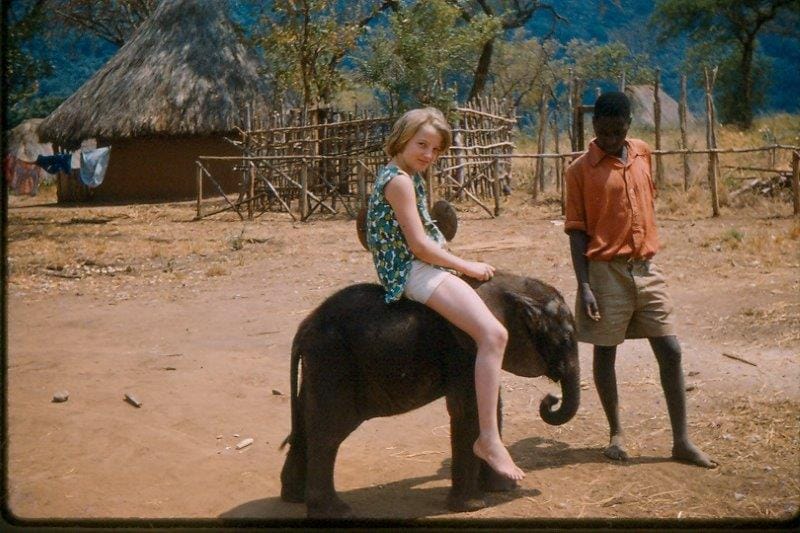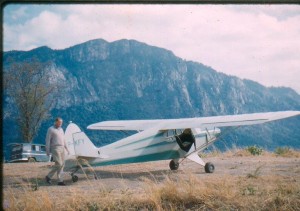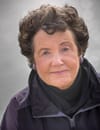Experiencing the Best of Africa

David Read’s niece, Marilynne, sitting on his pet elephant which was tended by a full time keeper. In the background is the elephant’s boma next to the keepers hut. Aug 1961
Experiencing the Best of Africa
On return to Ketembelion Farm from the seaside David Read, on a neighboring Ol Molog farm, invited Tim to spend a few days with him. He and his wife, Pat, also owned Keru Farm, in the Rift Valley, where they grew papaws (papaya) for papain production. Pat’s African cook loaded David’s Willys Jeep station wagon with equipment. He acted as Tim’s guide as they made the long trek south-west of Arusha while David, Pat and his niece flew in their Piper Cruiser.
Experiencing the Best of Africa
On arrival, David flew Tim around the large property, swooping down on groups of workers to check on their work. One boundary of the farm was the sheer cliff wall of the rift valley.
On the ground, he took Tim in the jeep to see vast areas of pawpaws, channel irrigation from natural springs flowing from the rift wall. Workers scratched unripe fruit, causing white sap to drip onto circular canvas trays clipped to the tree trunks. When a tree was bled sufficiently the tray was moved to an adjacent tree and the process repeated. Ripe fruit was discarded, being too far from markets.
The semi-dry sap was hot air-dried into a white powder. The finished product was packed into twenty litre drums for export to Europe to be used in the production of paints and meat tenderizers.
David kept a pet baby elephant on the farm. A keeper was assigned to look after it. It completely bonded, following the keeper everywhere. At night a strong timber stockade was used to keep it safe. One day when the keeper took an unauthorized afternoon nap, the elephant found its way into the African’s hut and climbed onto the bed with him. The bed collapsed. The farm laborers thought it was a hilarious joke. The elephant’s favorite toy was an empty 200 litre drum which it would roll along at high speed, making the free range hens scatter in all directions.
At that time David was a serious competitor in the East African car rallies and gave Tim a practical demonstration of that type of driving. Traveling in the jeep, some distance from the airstrip, a private plane flew over to land. David knew the pilot would only stay a short while to deliver machinery parts, but he wanted to talk to him. He said, “Hold on Tim! I will show you some safari driving.” He took off at full throttle, twisting and sliding sideways, between trees, on the narrow farm tracks. Tim was a little worried at times, especially when loose objects in the back of the vehicle shot from one side to the other. They reached the airstrip in time.
A day or two later, the Reads flew home in their plane and Tim drove the Jeep back to Ol Molog. He was thrilled to see Kilimanjaro towering above the plains in front of him, magnificent with the snow visible above the clouds. He pulled up on the dusty track. A circular hatch in the roof had been fitted to the vehicle by the film company who made the movie Hatari, starring John Wayne. He used it to take a picture.
Back with the Freyburgs, Tim made plans for his return home to Rhodesia and his father’s Melrose Farm. Brian had business to attend to in Nairobi and offered him a ride in Whizzer. Tim gratefully accepted, and bade a fond farewell to all the family. He connected with a BOAC flight to Salisbury on 31st August, 1961.

David Read’s Piper Cruiser and Hatari John Wayne jeep parked on his Keru Farm in the Rift Valley August 1961
David Read, born in Nairobi, is the author of Barefoot Over The Serengeti, Waters Of The Sanjan and Beating About The Bush. He lived in Masai-land when he was young and became fluent in local African languages.
Many thanks to Tim Hughes for this excerpt and photo from his unpublished manuscript Matambega and Son written in the 1980’s.
